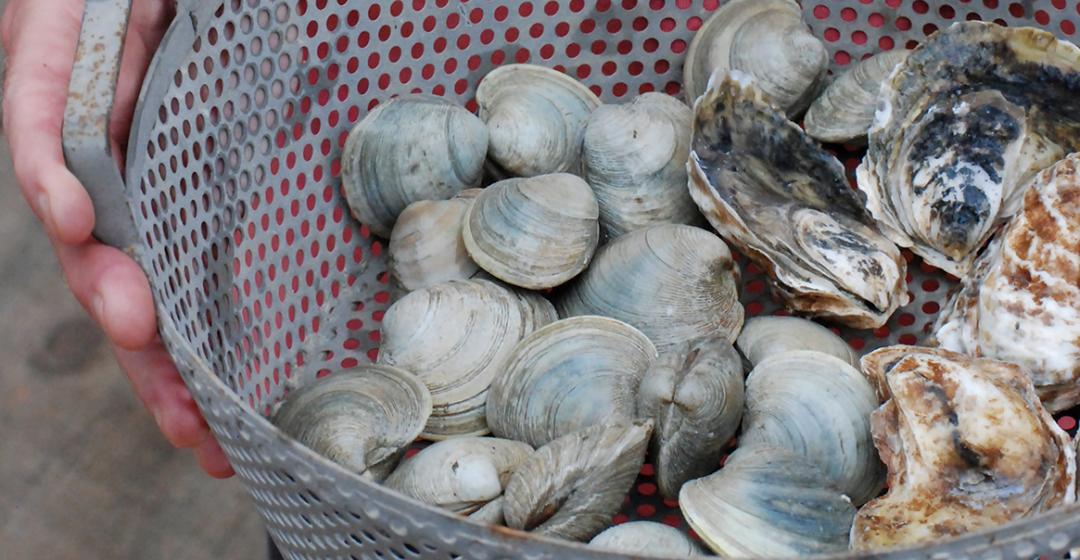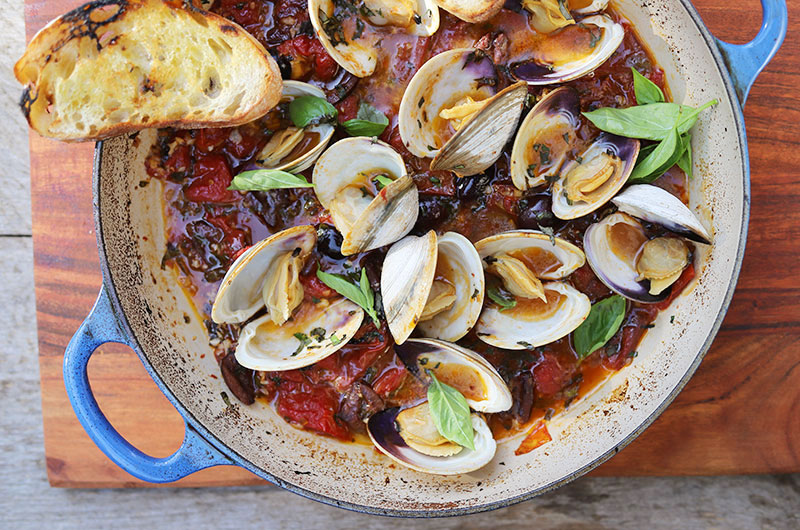We didn’t call them littlenecks or cherrystones or quahaugs. We just called them clams, and we dug them up with our toes out of the soft creamy sand out on the sandbar we traveled to on my cousins’ Boston whaler. Occasionally we collided with a pinching blue crab (ouch!) or, worse, a jellyfish while wading in the shallow water. My big cousins cracked the clams on the side of the boat and ate them raw.
Later, my uncles would shuck the rest properly at my grandmother’s house, and we would eat them out back in the cool early evening before the main meal of fried flounder and Sussex County succotash with pole lima beans, frozen by the quart by my father and grandmother late in the summer.
My father was forever teasing my sister and me about our reluctance to embrace raw clams. “They scream when they go down your throat, you know,” he’d say.
Thanks, Dad. To this day, my sister isn’t big on any raw shellfish, but I seem to have gotten over the trauma. (It didn’t help that our little beach cottage was downwind of a clam factory, where piles of shells baked in the hot sun and the afternoon westerly brought the putrid scent of rotting bivalves our way. The dog loved it, I’ll say that.)
That was Delaware and this is Martha’s Vineyard, though my heart still skips a beat when I see chips and shards of purple clam shell in the soft sand at low tide on the North Shore. We didn’t have wampum jewelry either, but we loved to collect clam shells for various arts and crafts projects on rainy days.
I think the abundance of uber-fresh local shellfish is one more reason why I felt I’d come home when I came to the Vineyard twelve years ago and essentially never left. These days I rarely have time to dig my own clams; fortunately, this being the Vineyard, they often show up on the back step anyway. Friends go clamming, get carried away, and decide they have too much. They don’t even ask; they just assume you want some. Giving things away is simply what people do around here.
But most often when I’m planning to put clams on our dinner menu, I call Mike Holtham, manager of The Net Result in Vineyard Haven, to see if he has fresh littlenecks coming in. “Yes,” he’ll say to me, “I’ve got a guy out right now and he’s bringing them straight over to me this afternoon; come on by after three.” Or I’ll just head down there, where they’re usually in stock anyway, along with the bigger cherrystones and quahaugs.
And while I like raw clams, I’m not much of a shucker, so I prefer to steam my clams open either on the stovetop, in the oven, or on the grill in the summer.
In my first cooking job at Al Forno restaurant in Providence, Rhode Island, I learned to appreciate the deliciousness of oven-roasted clams cooked in a tasty sauce and served right in the baking dish. I’ve been tinkering with my own version of clams al forno ever since.
As it happens, early fall on the Vineyard is also when we get our very best beefsteak tomatoes. (This used to cause me much despair when I had a farm stand and the tourists would leave in August and my tomatoes would start ripening like crazy in September.) So a dish of roasted clams in a garlicky, oven-roasted tomato sauce is about as Vineyard-y good as it gets this time of year.
The recipe I’ve developed has kalamata olives and basil in it, in addition to chopped ripe tomatoes (plum or beefsteak, doesn’t matter), garlic, and some wine. I think the olives provide a huge jolt of flavor, but if you don’t like olives, no worries; the real secret here is to give the chopped tomatoes – tossed with oil and spread out in a baking dish – a head start on the clams so that they’ll cook down somewhat and turn deeply flavorful. Once the clams (and a few other ingredients) join them in the pan, it’s no more than fifteen minutes till dinner time.
I’ve found that, before cooking, all our Vineyard littlenecks need is a light scrubbing. When they open up in the oven, they don’t seem to let loose sand or grit – just a bit of those delicious briny juices that then meld with the pan sauce.
As to how you will know when your clams are cooked? When they open up, of course. Now, it is possible to overcook clams no matter what method you choose to cook them, but there are two ways to avoid that.
First, when you’re at the seafood counter, ask if you can have clams all about the same size. Even within the classification of littlenecks, there is a bit of range. While you’re at it, ask for clams by the count rather than the pound. If you’re in a huge rush, you could simply ask for about two pounds, but most likely you’ll then get only about twenty clams. If possible, ask for twenty-four clams, since twelve will fit in each of the baking dishes.
Second, when roasting, give the clams eight to ten minutes, open the oven, and peek. Actually, do more than just peek – use tongs to jostle the clams around a bit, flipping some to help them along. Check again in five or six minutes and they should all be open. (You’re cooking in a pretty hot oven – 425 degrees.) Theoretically, you should discard a clam that stubbornly won’t open (meaning it may not have been alive when it went in the oven), but if it is just partially open, it’s most likely fine, and you can pry the shells apart with tongs or a fork.
I think perhaps because of the restaurant’s influence, I love to serve these oven-roasted clams right in the baking dish they’re cooked in. It’s fun, though I recommend using wooden cutting boards as placements for the hot dishes.
Bread – toasted, broiled, or grilled – is essential for scooping up the sauce. In our household, I eat the roasted clams (and sauce) by spooning them on top of the bread, bruschetta-style. But there are other less genteel members of the household who simply run the bread around the edges of the dish until everything is mopped up. If the whole bread thing doesn’t work for you, by all means, feel free to scoop the clams and sauce out of the baking dish (while still piping hot, of course) and serve them over pasta, white beans, or even mashed potatoes as we did at Al Forno. There will be no screaming involved.








